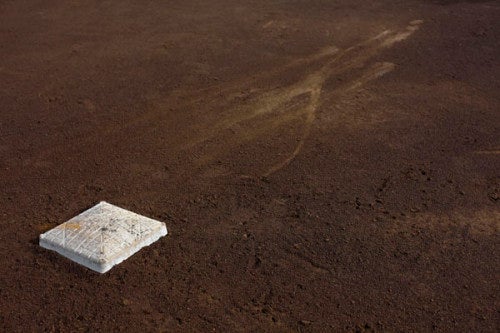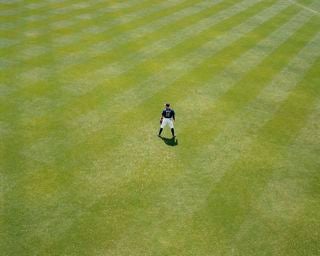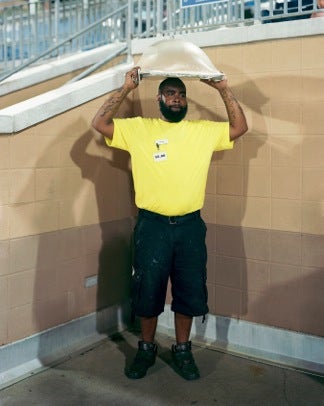
Bull City Summer: A Season at the Ballpark & Beyond is a documentary project with a brilliant premise: ten artists and five writers cover all 72 home games of the Durham Bulls. The effort, undertaken in 2013, marked the 25th anniversary of the movie Bull Durham, the Kevin Costner / Susan Sarandon romance steeped in an authentic baseball setting.
On view at the Contemporary Art Museum and the North Carolina Museum of Art in Raleigh, photographs by Alex Harris, Frank Hunter, Kate Joyce, Elizabeth Matheson, Hank Willis Thomas, Leah Sobsey, Alec Soth, Tim Telkamp, Hiroshi Watanabe and Jeff Whetstone range from abstracting the familiar to celebrating broad swathes of humanity who sweat and cheer together on hot summer days.

Did all of the artists love baseball? Do you have to like baseball to enjoy this? No need to worry because, as Adam Sobsey, one of the writers involved in the project (and brother of photographer Leah), wrote in a Paris Review blog post about the project last July: “Not really about baseball.” In my scorebook, Alec Soth and Kate Joyce steal both shows. It may come as no surprise how different all of the photos appear from baseball coverage in the mainstream news, and that distinction was strongest with their respective focuses.
Soth’s photos have one of two vantage points: the players are distant, and the spectators and vendors are near, setting up a familiar paradigm for game-goers. This realism increases our emotional connection to his series. The athletes are surrounded by stretches of green ballpark grass, complete with neat mown grids. They don’t catch or run but stand like action figures that could be picked up. Meanwhile, the spectators and vendors are at conversational distances.

Jamal, a vendor with tattooed forearms and a neon yellow T-shirt, has a $5 price tag stuck right next to his name tag, in larger print than his name. He avoids eye contact and stands with his back to a concrete corner of the stadium, seeming vaguely hunted. Holly is a young blonde woman in a pink shirt with pink-painted nails, wearing a Band-Aid on her finger that precisely matches her shirt. Her eye contact shows a different dynamic than Jamal, and Soth has said his photos are as much about the space between him and the person depicted as the physical features the photo records. In an exhibition that is strikingly humanist, these close-ups are tender, with piercing verisimilitude that suspends us in specific moments.
Joyce makes photos that at first appear as though they research the sport. Her diverse series share a mood of focused examination: a close look at phenomena that may or may not have meaningful thesis statements. The photo 2nd Base, Post Game has a grave aspect and gorgeous texture, making a portentous still life of a base and skid marks left in the gravel. A photo grid titled Impact of a Ball and the Outfield Wall shows, in sober crime-scene detail, the marks that chalk-dust coated balls left on the “blue monster” stadium wall of the Durham Bulls Stadium. The Field of Play is also a grid of photos, these of tiny airplanes the bullpen pitchers folded from gum wrappers. Pops of color occur at the same area in each image, where the noses of the planes pitch into the grass. Additionally, Joyce captured video footage of practice in Hit and Pitch, displayed beautifully in a reduced palette in a darkened room at CAM that leads to a video by Ivan Weiss that documents each photographer’s work. Joyce’s videos focus on physical repetition and come across as a coach’s review of an athlete’s performance, except that most of us don’t know which swings are the best, so it becomes a pure aesthetic practice.
Hank Willis Thomas’s work demonstrates the endurance that goes into an entire home season. Seventy-two games is a lot of playing, and it’s also a lot of watching for devoted fans. Thomas’s piece focuses on a single game, engaging a team of 10 collaborators in A Futile Attempt to Take a Portrait of Everyone Who Attended the Last Regular-Season Game. His goal was to capture the feeling of community he felt that season. In his artist statement in the show’s accompanying catalogue, Thomas says, “I was really trying to figure out how to make something personal and unique that had a voice. Ironically, it took a chorus of voices to do that.”
At the NCMA, the hundreds of snapshots are arranged in three grids with so many tiny faces that trying to note each face is futile. At CAM, Thomas’s piece is more successfully presented on large, vertically oriented flat screens, the 2-foot-high faces flashing by. Two stadium seats face the screens, welcoming you to sit and partake in all the smiles that capture the festive mood of watching a ballgame in person.

The most abstract and resonant series is by Jeff Whetstone, who digitally rendered “score drawings” by the writer Adam Sobsey into larger-than-life prints. The letters, slashes, and diamonds record major plays on a basic square grid. Sobsey was one of five writers to document the 2013 home season of the Bulls. The drawings, like arcane tic-tac-toe or pictorial haiku, make evident the writer’s love for the game. Sobsey alone can translate them, yet he doesn’t return to them later. The marks are meditative accompaniments to his game viewing. Like Joyce’s videos, Whetstone presents the cryptic marks for aesthetic contemplation, a Duchampian gesture that reverts the readymade to the hand-made. The photos layer the practice of viewing art onto the process of watching a sport, and both reward close and extended attention.
Baseball is an accessible sport, and it is fitting that the artwork in “Bull City Summer”is driven more by documentary than conceptual impulses. The range of artistic voices is what makes this project innovative.
“Bull City Summer” was conceived by North Carolina native Sam Stephenson and is the inaugural project of his new Rock Fish Stew Institute of Literature and Materials. The exhibition is on view at the North Carolina Museum of Art and the Contemporary Art Museum Raleigh through August 31.
Shana Dumont Garr is a Raleigh-based contemporary art curator, writer, and the Director of Programs and Exhibitions at Artspace, NC.




